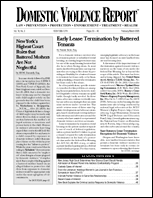Complete Issue
Author: Merle H. Weiner.
Source: Volume 25, Number 01, October/November 2019 , pp.1-28(28)

< previous article |return to table of contents
Abstract:
This issue of Domestic Violence Report focuses on child abduction, particularly international child abduction. One cannot talk about international child abduction without also discussing domestic violence. The topics go hand in hand. Perpetrators of domestic violence abduct their victim’s children as a way to abuse the parent. In addition, domestic violence victims “abduct” their children when they flee for safety. The Hague Convention on the Civil Aspects of International Child Abduction (the Convention) is the legal instrument that applies to most international child abductions that originate from or conclude in the United States. The Convention’s operation over approximately the last 40 years reveals that the Convention works quite well when the abductor is a domestic violence perpetrator. However, the Convention can operate quite unjustly when the abductor is the domestic violence victim. Many courts in the United States, and abroad, have applied the Convention in ways that have harmed children and their domestic-violence-victim caregivers. The contributions that follow introduce some of the issues that arise under the Convention. They largely focus on instances when a domestic violence survivor “abducts” her child and then her batterer files a petition for the child’s return. Seventy-three percent (73%) of the international abductions are by mothers, and many claim to be fleeing from domestic violence. Joan Meier and Bryan Walsh describe Monasky v. Taglieri, a case that will be heard by the U.S. Supreme Court this term (it is the fourth Hague Abduction case to reach the U.S. Supreme Court and the third to involve allegations of domestic violence). Meier and Walsh offer a recommendation for how courts should analyze the child’s “habitual residence” when the abductor is a domestic violence victim and the child is an infant. Pamela Brown uses one of her own cases to illustrate the practical challenges that survivors and attorneys face when confronted with a Hague Convention case, noting the importance of both attacking the prima facie case (and habitual residence, in particular) and raising the applicable defenses (especially the article 13(b) “grave risk” defense). A few of the contributors then focus specifically on the article 13(b) “grave risk” defense. Lynn Hecht Schafran uses a recent opinion from the Second Circuit Court of Appeals to illustrate how courts’ application of that defense can harm survivors and children if courts have unrealistic faith in “undertakings” and other protective measures. Jeff Edleson’s piece focuses on the importance of expert testimony when a survivor raises the article 13(b) “grave risk” defense. My own article discusses a new Guide to Good Practice that the Hague Permanent Bureau is drafting about the article 13(b) defense. Sudha Shetty describes the resources her HagueDV project has contributed to the field, including bench guides for courts and handbooks for attorneys. Finally, Jane Stoever reminds us that that perpetrators can also be abductors, not only Hague Convention petitioners, and that systems also often fail domestic violence victims when their children are abducted. Together, these contributions are intended to provide a better understanding of the challenges involved in abduction cases, the vital role that attorneys can play, the importance of educating system actors (including judges) about aspects of this topic, and the need for legal reform.Keywords: International Child Abduction; Hague Convention on the Civil Aspects of International Child Abduction
Affiliations:
1: Guest Editor, University of Oregon.